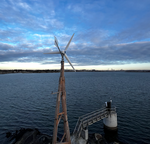News Release from TenneT TSO GmbH
Wind Industry Profile of
Roadmap for development of offshore grid in 2024-2030 period
The roadmap specifies which wind farm zones will be released for development in the Dutch sector of the North Sea, when this will occur, the projected generation capacity of these zones, and when they will be taken into operation. The continuation of this successful policy will provide clarity and assure continuity for the offshore wind industry as well as TenneT. The wind farms to be prepared in the coming years will be located in three wind farm zones called ‘Holland Coast (West)’, ‘North of the Wadden Sea Islands’, and ‘IJmuiden Far Offshore’.
Like the current roadmap for the period up to 2023, the new roadmap will provide essential guidelines for the further development of offshore wind energy in the period up to 2030. TenneT will connect the offshore wind farms via a so-called ‘offshore grid’. In the past year, TenneT has made preparations to develop innovative and cost-effective grid concepts for these offshore grid connections.
Capacity to increase from 4.5 GW to 11.5 GW in 2024-2030 period
Under the National Energy Agreement concluded in 2013, five offshore wind farms with a total capacity of 3.5 gigawatts (GW) will be built in the Dutch sector of the North Sea in the period until 2023, in addition to the existing wind farms, which have a total capacity of 1 GW. The coalition agreement provides for a further 7 GW increase in offshore wind energy capacity between 2024 and 2030.
Benefiting from current standardized connection technology
In TenneT’s view, the best way to connect wind farm zones located relatively close to the Dutch coast to the grid is to use Alternating Current (AC) technology. The energy produced in these zones can be transmitted via a standard TenneT transformer platform that is connected to an onshore high-voltage station located near the coast via 220 kV AC cables buried in the seabed. Each of these standardized connection systems has a capacity of 700 megawatt (MW), and will also be used by TenneT to connect the Borssele wind farm zone (2 × 700 MW) as well as the Holland Coast (South) (2 × 700 MW) and Holland Coast (North) (700 MW) wind farm zones. With a view to further cost reduction and limiting the space required, this new roadmap enables combined preparations for the connection of the northern section of the Holland Coast (West) and the existing Holland Coast (North) zone. The standardised 700 MW design will be optimised further for application in the ‘Holland Coast (West)’ and ‘North of the Wadden Sea Islands’ zones.
Island near ‘IJmuiden Far Offshore’ zone
In TenneT’s view, Direct Current (DC) connections will need to be used to be able to connect offshore wind energy on a large scale and across greater distances in a cost-effective way, as is the case with ‘IJmuiden Far Offshore’. Continued innovation should enable the development of DC connection capacities of between 1,200 and 2,000 MW. These higher capacities will then make it possible to integrate IJmuiden Far Offshore with fewer connections (e.g. cables) and with less spatial impact.
TenneT is working with relevant government departments to research the possibility of constructing an island in the ‘IJmuiden Far Offshore’ zone to accommodate a converter and transformer station, to which wind farms can then be connected. This may be more cost-effective than installing multiple large offshore DC platforms. In addition to potential economic benefits, an island would offer opportunities for converting wind power into hydrogen, facilitating a so-called ‘Wind Connector’, and creating port and maintenance facilities. A Wind Connector to the United Kingdom will make it possible to use the infrastructure for both connecting wind farms and further integration of the international electricity market. This will significantly improve – potentially even double – the usage efficiency of the offshore grid, and will contribute to a reduction of the cost price of offshore wind energy. An island in the ‘IJmuiden Far Offshore’ zone can also yield valuable experience for the creation, after 2030, of an even larger energy island in the North Sea farther offshore.
Electrification as a precondition for continued growth after 2030
It is expected that by 2030 situations where the supply of electricity from all renewable sources outstrips demand will be a highly frequent occurrence. This requires a further transition to a sustainable energy system, which could involve electrification to heat buildings, mobility and industry. The conversion of electricity to hydrogen is a possibility that deserves serious research.
Now that the Dutch government’s Offshore Wind Energy Roadmap 2030 has been published, TenneT is looking forward to collaborate closely with public- and private-sector parties to initiate the follow-up research required to flesh out the broad outlines for an offshore grid, followed by construction projects.
- Source:
- TenneT
- Author:
- Press Office
- Link:
- www.tennet.eu/...
- Keywords:
- TenneT, roadmap, development, Netherlands, offshore, grid


























